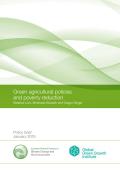This article looks at how China has moved forward in embracing green technology development, the government’s role in that growth and whether its support is truly harmful on a global scale. It highlights key laws in the United States and the WTO involving trade - specifically subsidies, countervailing duties and anti-dumping regulations. An examination of recent trade cases involving the United States and China is followed by an analysis of America’s recent trade-oriented actions and legislation. Lastly, this article considers the legal implications of recent trade developments between these countries as well as policy implications, including the effect on the green and renewables industry.


Current models examining the possible implications which changes towards a low-carbon economy may reflect for low-income countries include a look at best practices from countries such as Kenya, Cambodia and Nepal, some of which may also prove relevant for the Caribbean context. To this end, ten key measures were identified by the Overseas Development Institute (ODI) which could help such countries to remain competitive in a future low-carbon global economy. These ten measures further assisted in examining the Caribbean context and may be seen to sum up the various observations and recommendations already examined within this paper.
Building on the case study of the shea butter supply chain in Burkina Faso, this article proposes an original approach consisting of improved energy use for a more competitive and sustainable activity. The traditional butter production process consumes a great deal of energy from firewood and generates a lot of organic waste that could be used as an energy source. We examined the feasibility of using alternative energy techniques that could be taken on board as they are simple and designed from local resources, whilst using by-products from the shea butter production chain as biofuels to partially replace firewood. The study shows that using alternative energy techniques, taken one by one or combined, can lead to lower energy use and thereby increase women's incomes, whilst helping to conserve forests.
This paper illustrates the foundations of green growth in Zambia and provides an overview of green development co-operation efforts in the country from 2004 to 2012. Furthermore, it discusses on-going efforts towards greening growth in Zambia. Aditionally, the study looks at total bilateral green Official Development Assistance (ODA) flows from members of the Organisation for Economic Co-operation and Development’s (OECD) Development Assistance Committee (DAC) member countries, i.e. targeting biodiversity, climate change adaptation, climate change mitigation, desertification, and other environmental objectives. This analysis draws on OECD DAC statistics, in particular the Creditor 10 Reporting System (CRS). It describes the sectors targeted, as well as the instruments used, and discusses the degree of alignment between Zambian priorities and providers’ activities. Another section of the paper then explores specific provider co-ordination efforts and strategies to support the mainstreaming of green issues incountry. The paper concludes with a number of questions that could guide further research on this topic in Zambia and beyond.
